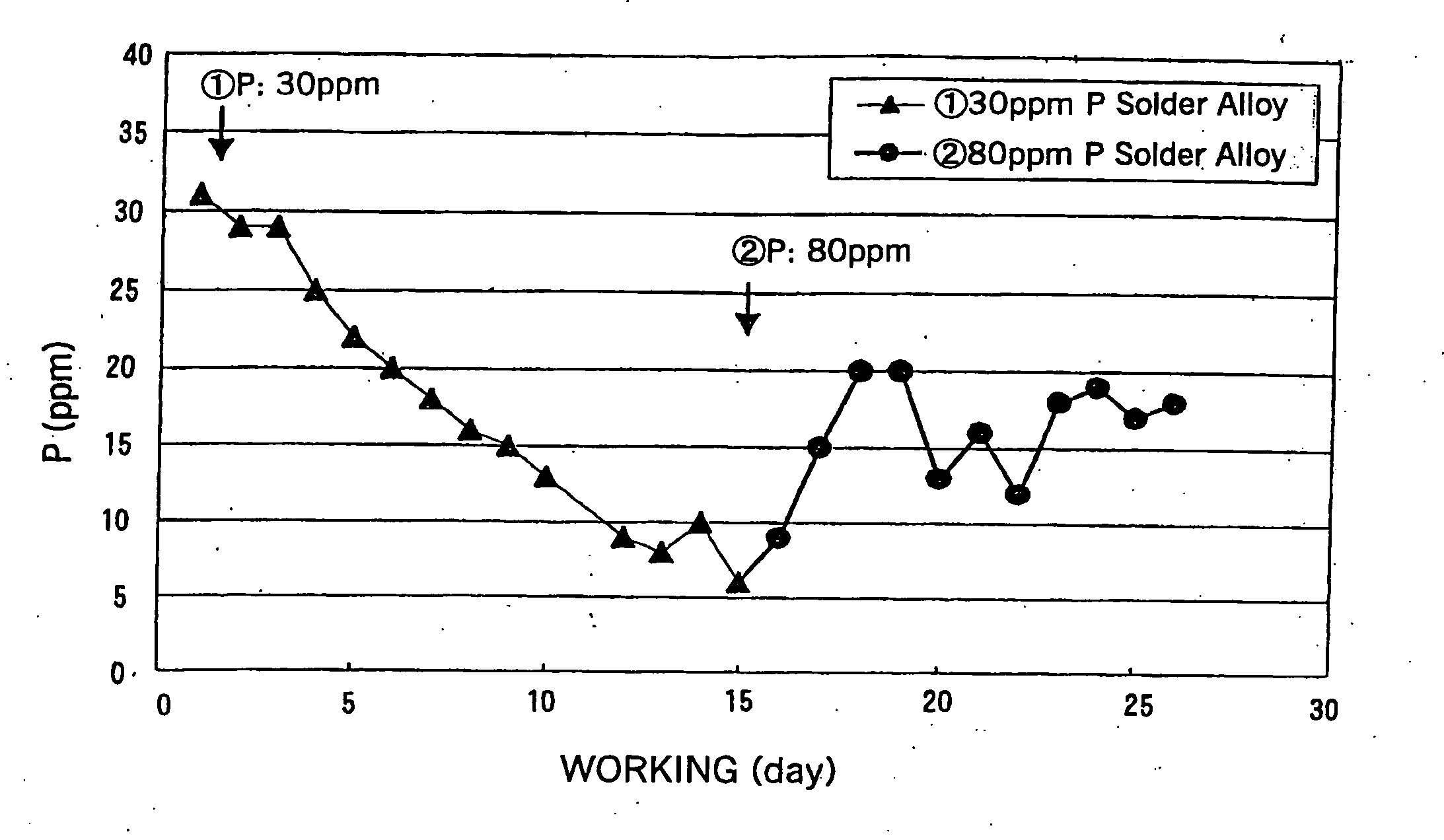Soldering method and solder alloy for additional supply
- Summary
- Abstract
- Description
- Claims
- Application Information
AI Technical Summary
Benefits of technology
Problems solved by technology
Method used
Image
Examples
example 1
[0078] Specific steps in carrying out this example are as follows.
[0079] (1) Sn-3.0Ag-0.5Cu-0.003P solder, which is a P-containing lead free solder alloy suitable for suppressing oxidation of molten solder, was melted to form a solder bath (weight: 330 kg).
[0080] (2) The decrease in the amount of the solder bath in the soldering tank during 12 days of operation, i.e., the replenished amount of the solder alloy and the rate of decrease of the P concentration were determined.
[0081] Total supplied amount of Sn-3.0Ag-0.5Cu-0.003P solder alloy to the solder bath: 220 kg
[0082] Concentration of P in the solder bath after 12 days of operation: 0%
[0083] (3) The average decrease per day in the amount of the oxidation suppressing element for 12 days was determined, a supplied amount corresponding thereto was calculated, the concentration of P in the replenishment solder alloy was set, and such a solder alloy was manufactured.
[0084] Solder supply amount: 20 kg / day
[0085] P decrease: 2 g / d...
example 2
[0089] This example illustrates the case in which a solder alloy not containing Cu is supplied as a replenishment solder alloy.
[0090] (1) An Sn-3.0Ag-0.5Cu-0.003P solder, which is a P-containing lead free solder alloy suitable for suppressing oxidation of solder, was melted to fill a soldering tank to form a solder bath (weight: 330 kg).
[0091] (2) The decrease in the amount of the solder bath in the soldering tank during 9 days of operation, i.e., the supplied amount of the solder alloy and the rate of decrease of the P concentration were determined. In this example, the composition of the replenishment solder alloy, except for P, was Sn-3.0Ag.
[0092] Total supplied amount of Sn-3.0Ag-0.003P solder alloy to the solder bath: 90 kg
[0093] Concentration of P of the solder bath after 9 days of operation: 0%
[0094] (3) The average decreases per day in the amount of the solder bath and of the oxidation suppressing element for 9 days were determined, supplied amounts corresponding theret...
example 3
[0100] This example illustrates the case in which a Pb-containing solder alloy is used as a replenishment solder alloy.
[0101] (1) A Pb-63Sn-0.003P solder, which is a P-containing solder alloy suitable for suppressing oxidation of solder, was melted to form a solder bath (weight: 330 kg).
[0102] (2) The decrease in the amount of the solder bath in the solder bath during 14 days of operation, i.e., the supplied amount of the solder alloy and the rate of decrease of the P concentration were determined. In this example, the composition of the replenishment solder alloy, except for P, was Pb-63Sn.
[0103] Total supplied amount of Pb-63Sn solder alloy to the solder bath: 200 kg
[0104] Concentration of P in the solder bath after 14 days of operation: 0.001%
[0105] (3) The average decreases per day in the amount of the solder bath and the amount of the oxidation suppressing element for 14 days were determined, supplied amounts corresponding thereto were calculated, the concentration of P in...
PUM
| Property | Measurement | Unit |
|---|---|---|
| Fraction | aaaaa | aaaaa |
| Fraction | aaaaa | aaaaa |
| Fraction | aaaaa | aaaaa |
Abstract
Description
Claims
Application Information
 Login to View More
Login to View More - R&D
- Intellectual Property
- Life Sciences
- Materials
- Tech Scout
- Unparalleled Data Quality
- Higher Quality Content
- 60% Fewer Hallucinations
Browse by: Latest US Patents, China's latest patents, Technical Efficacy Thesaurus, Application Domain, Technology Topic, Popular Technical Reports.
© 2025 PatSnap. All rights reserved.Legal|Privacy policy|Modern Slavery Act Transparency Statement|Sitemap|About US| Contact US: help@patsnap.com


